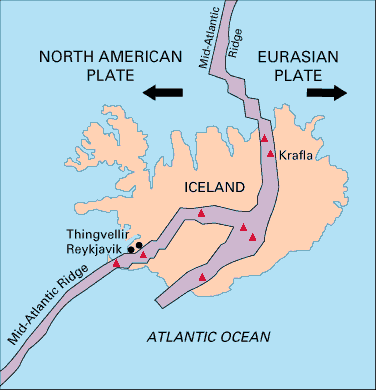Iceland is located at a divergent plate boundary over the Mid-Atlantic Ridge, along which the North American Plate and Eurasian Plate are being pushed apart by newly formed crust (diagram below from USGS Credit: U.S. Geological Survey Department of the Interior/USGS)
A deep-seated mantle plume is also present in the area and interacts with the North American Plate. This plume (or hotspot) and the active spreading axes are producing the volcanism of present day Iceland. The map below (from R.G. Trønnes, Nordic volcanological Institute, University of Iceland) shows both the active and old spreading axes as well as the position of the mantle plume between present day and 40 million years ago.
The ash cloud from the icelandic volcanic eruption was observed in the Northern part of Romania on April 16 and 17, but Romania had ash produced from its own volcanoes as recently as 10,000 years ago. In contrast to Iceland, the Romanian volcanoes were active at a convergent plate margin. The resulting volcanic arc deposits are Neogene to Quaternary in age and are located in the Northern part of the Eastern Carpathian mountains. The map below (from A. Szakracs,I. Seghedi, 1995) shows the volcanic cones and the associated deposits in Calimani-Gurghiu-Hargita mountains.
The Eastern Carpathians volcanic arc is 160km long, the longest in the entire Carpathian mountain belt. It formed as a result of the convergence between two plate fragments, the Transylvanian micro-plate and the Eurasian plate. The volcanic activity spanned from ~15 Ma to 0.01 Ma ago. The area is interesting not only from the geological point of view, but also for its natural beauty, but about this in another post.




